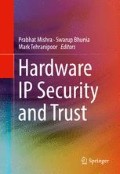Abstract
Reusable hardware Intellectual Property (IP)-based System-on-Chip (SoC) design has emerged as a pervasive design practice in the industry to dramatically reduce design and verification cost while meeting aggressive time-to-market constraints. Growing reliance on these pre-verified hardware IPs, often gathered from untrusted third-party vendors, severely affects the security and trustworthiness of SoC computing platforms. An important emerging concern with the hardware IPs acquired from external sources is that they may come with deliberate malicious implants to incorporate undesired functionality, undocumented test and debug interface working as hidden backdoor, or other integrity issues. This chapter describes various security and trust vulnerabilities in third-party hardware IPs.
Access this chapter
Tax calculation will be finalised at checkout
Purchases are for personal use only
References
D. Evans, Cisco white paper on the internet of things: how the next evolution of the internet is changing everything (April 2011). www.cisco.com/c/dam/en_us/about/ac79/docs/innov/IoT_IBSG_0411FINAL.pdf. Accessed 8 Nov 2016
M. Keating, P. Bricaud, Reuse Methodology Manual for System-on-a-Chip Designs (Kluwer, Norwell, MA, 1998)
S. Bhunia, D. Agrawal, L. Nazhandali, Guest editors’ introduction: trusted system-on-chip with untrusted components. IEEE Des. Test Comput. 30 (2), 5–7 (2013)
M. Chen, X. Qin, H. Koo, P. Mishra, System-Level Validation: High-Level Modeling and Directed Test Generation Techniques (Springer, New York, 2012)
Y. Huang, S. Bhunia, P. Mishra, MERS: statistical test generation for side-channel analysis based Trojan detection, in ACM Conference on Computer and Communications Security (CCS) (2016)
X. Guo, R. Dutta, P. Mishra, Y. Jin, Scalable SoC trust verification using integrated theorem proving and model checking, in IEEE International Symposium on Hardware Oriented Security and Trust (HOST) (2016), pp. 124–129
F. Farahmandi, Y. Huang, P. Mishra, Trojan localization using symbolic algebra, in Asia and South Pacific Design Automation Conference (ASPDAC) (2017)
X. Guo, R. Dutta, Y. Jin, F. Farahmandi, P. Mishra, Pre-silicon security verification and validation: a formal perspective, in ACM/IEEE Design Automation Conference (DAC) (2015)
S. Skorobogatov, C. Woods, Breakthrough silicon scanning discovers backdoor in military chip, in CHES 2012. Published in Lecture Notes in Computer Science, vol. 7428 (2012), pp. 23–40
Ellen Messmer, RSA security attack demo deep-fries Apple Mac components, Network World (2014). http://www.networkworld.com/article/2174737/security/rsa-security-attack-demo-deep-fries-apple-mac-components.html
P.C. Kocher, Timing attacks on implementations of diffie-hellman, RSA, DSS, and other systems, in CRYPTO (1996), pp. 104–113
F. Wolff, C. Papachristou, R. Chakraborty, S. Bhunia, Towards Trojan-free trusted ICs: problem analysis and a low-overhead detection scheme, in Design Automation and Test in Europe (DATE) (2008)
L. Lin, W. Burleson, C. Parr, MOLES: malicious off-chip leakage enabled by side-channels, in International Conference on CAD (ICCAD) (2009)
R. Chakraborty, F. Wolff, S. Paul, C. Papachristou, S. Bhunia, MERO: a statistical approach for hardware Trojan detection, in Workshop on Cryptographic Hardware and Embedded Systems (CHES) (2009)
S. Narasimhan, X. Wang, D. Du, R. Chakraborty, S. Bhunia, TeSR: a robust temporal self-referencing approach for hardware Trojan detection, in 4th IEEE International Symposium on Hardware-Oriented Security and Trust (HOST) (2011)
Author information
Authors and Affiliations
Corresponding author
Editor information
Editors and Affiliations
Rights and permissions
Copyright information
© 2017 Springer International Publishing AG
About this chapter
Cite this chapter
Mishra, P., Tehranipoor, M., Bhunia, S. (2017). Security and Trust Vulnerabilities in Third-Party IPs. In: Mishra, P., Bhunia, S., Tehranipoor, M. (eds) Hardware IP Security and Trust. Springer, Cham. https://doi.org/10.1007/978-3-319-49025-0_1
Download citation
DOI: https://doi.org/10.1007/978-3-319-49025-0_1
Published:
Publisher Name: Springer, Cham
Print ISBN: 978-3-319-49024-3
Online ISBN: 978-3-319-49025-0
eBook Packages: EngineeringEngineering (R0)

